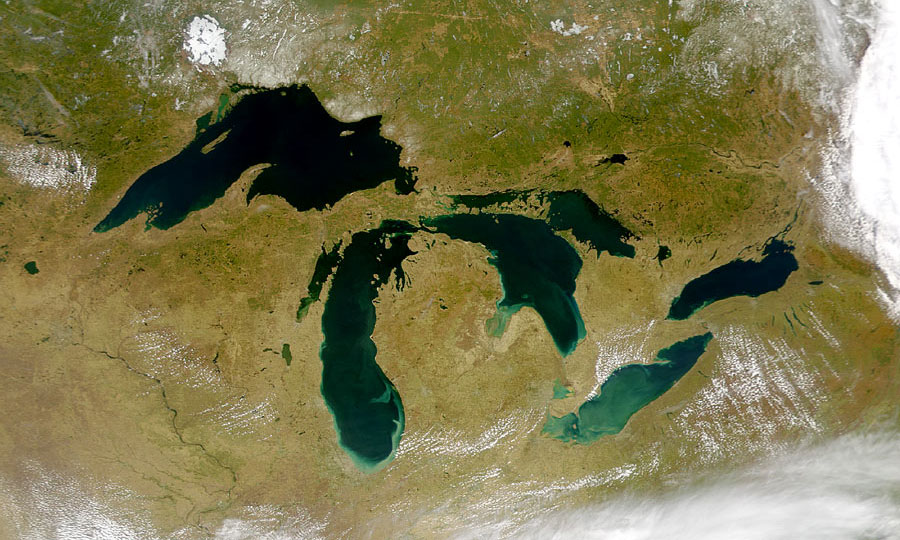These publications were recently added to GLRPPR’s Sector Resources. This list is also available as an RSS feed at http://www.istc.illinois.edu/info/library_docs/SectorRSS.htm.
A New Source of Methylmercury Entering the Pacific Ocean
Wed, 06 May 2009 20:27:45 GMT
A U.S. Geological Survey (USGS) scientist and his university colleagues have discovered a new source of methylmercury entering the waters of the eastern North Pacific Ocean. Consumption of ocean fish and shellfish account for over 90 percent of human methylmercury exposure in the United States, and tuna harvested in the Pacific Ocean account for 40 percent of this total exposure (Sunderland, 2007). Given the obvious importance of marine food webs to human methylmercury exposure, scientists were still trying to answer the question – where do fish, such as Pacific Ocean tuna, acquire their methylmercury? The findings of these scientists published in the journal Global Biogeochemical Cycles, might be a major step forward toward solving this mystery.
EPA Lifecycle Analysis of Greenhouse Gas Emissions from Renewable Fuels
Wed, 06 May 2009 19:18:15 GMT
Ass part of proposed revisions to the National Renewable Fuel Standard program (commonly known as the RFS program), EPA analyzed lifecycle greenhouse gas (GHG) emissions from increased renewable fuels use. The Energy Independence and Security Act of 2007 (EISA) establishes new renewable fuel categories and eligibility requirements. EISA sets the first U.S. mandatory lifecycle GHG reduction thresholds for renewable fuel categories, as compared to those of average petroleum fuels used in 2005. The regulatory purpose of the lifecycle greenhouse gas emissions analysis is to determine whether renewable fuels meet the GHG thresholds for the different categories of renewable fuel.
Green Roofs for Stormwater Runoff Control
Wed, 06 May 2009 19:14:03 GMT
This project evaluated green roofs as a stormwater management tool. Specifically, runoff quantity and quality from green and flat asphalt roofs were compared. Evapotranspiration from planted green roofs and evaporation from unplanted media roofs were also compared. The influence of media type, media depth and drought during plant establishment on plant growth and long-term management of media pH were investigated. The goal of the project was to provide high-quality replicated data which could be used to develop and refine reliable anticipated runoff volumes and loadings from green roofs, respectively, as well as evaluate factors which impact plant growth and establishment. Results indicate that the green roofs are capable of removing 50% of the annual rainfall volume from a roof through retention and evapotranspiration. Rainfall not retained by green roofs is detained, effectively increasing the time to peak, and slowing peak flows for a watershed. There are seasonal considerations as more runoff is generated during winter and for many summer storms there was no runoff. Green roof runoff does contain concentrations of some nutrients and other parameters, but values are in line with other planted systems. Due to the volume reduction, actual nutrient loadings from green roofs are less than asphalt roofing runoff or otherwise manageable at the downspout.
Product Policy Institute
Tue, 21 Apr 2009 18:27:13 GMT
Product Policy Institute (PPI) is a North American not-for-profit education and technical assistance organization. Their mission is to prevent waste and to promote sustainable production and consumption practices through good public policy and governance.
State of Green Business 2009
Tue, 14 Apr 2009 20:09:18 GMT
This year’s Green Business report is a mixed bag of encouraging and discouraging news. But on balance, despite a growing chorus of corporate commitments and actions, we’re less optimistic that these activities, in aggregate, are addressing planetary problems at sufficient scale and speed.
Landscape Sustainability
Fri, 03 Apr 2009 14:37:55 GMT
This guide from the University of Nebraska Extension describes how to use aesthetic, functional and environmentally sound design principles to create a sustainable landscape.
Compact Fluorescent Bulbs: Clean-up and Disposal Guide
Tue, 24 Mar 2009 21:41:50 GMT
Compact fluorescent bulbs provide highly efficient lighting, but contain mercury. Learn how to clean up broken bulbs and dispose of them safely.
Greenhouse Gas Sequestration by Algae — Energy and Greenhouse Gas Life Cycle Studies
Wed, 18 Mar 2009 20:09:26 GMT
We have examined various scenarios involving the growth of algae and the sequestering of carbon during its growth. End-uses for algae are found in the production of food supplements for humans; animal feed; oil extraction and its transesterification to produce biodiesel; electricity production upon combustion directly or by transforming the algae to methane anaerobically; or fuel production via pyrolysis, gasification or anaerobic digestion. In every case, the greenhouse gases sequestered by the algae are released into the atmosphere, so that greenhouse gas benefits arise only as offsets when the algal use displaces the combustion of a fossil fuel in a vehicle or for the production of electricity. This paper examines the greenhouse gas, costs and energy balance on a life-cycle basis for algae grown in salt-water ponds and used to produce biodiesel and electricity. Under the conditions described and the data assumed, it is shown that it is possible to produce algal biodiesel at less cost and with a substantial greenhouse gas and energy balance advantage over fossil diesel. However, when scaled up to large commercial production levels, the costs may exceed those for fossil diesel. The economic viability is highly dependent upon algae with high oil yields capable of high production year-round, which has yet to be demonstrated on a commercial scale.
Homegrown Prosperity from the Bottom Up
Wed, 18 Mar 2009 19:55:50 GMT
A new report by WORC presents policy-makers and prospective producers with information on small and community-scale biodiesel production. Homegrown Prosperity from the Bottom Up looks at the biodiesel industry as it is emerging in the rural economies across the region. It examines the experiences of farmers and local entrepreneurs in their public and private partnerships to start a new industry, and it assesses the potential contributions of this new economic engine to rural income and jobs. This report presents six case studies on the economic potential, legal and systemic issues, sustainability, and available technical assistance and financial resources.
